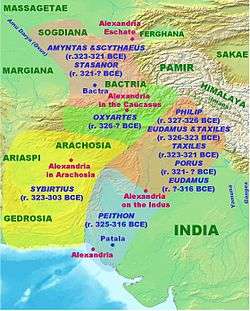Oxyartes
- For the stick insect genus, see Oxyartes (insect).

Oxyartes (Greek: Oxyártēs, in Persian: وخشارد (Vaxš-ard), from an unattested form in an Old Iranian language: *Huxšaθra-[1]) was a Sogdian[2][3][4] nobleman of Bactria, father of Roxana, the wife of Alexander of Macedon. He is first mentioned as one of the chiefs who accompanied Bessus on his retreat across the Oxus river into Sogdiana (329 BC).[5] After the death of Bessus, Oxyartes deposited his wife and daughters for safety in a rock fortress in Sogdiana, which was deemed impregnable, but nevertheless soon fell into the hands of Alexander's forces. Alexander not only treated his captives with respect and attention, but was so charmed with the beauty of Roxana as to decide that he wanted to make her his wife. Oxyartes, on learning these tidings, is said to have hastened to make his submission to Alexander, who received him with the utmost distinction. The nuptials of his daughter with the king in 327 BC were celebrated with a magnificent feast.[6]
Shortly after this event, Oxyartes successfully persuaded Chorienes to surrender his rock fortress. Subsequently, he was appointed by Alexander as satrap of the province of Paropamisadae in India.[7] He continued to hold this position until the death of Alexander (323 BC). Oxyartes was confirmed in his position both in the first division of the provinces immediately after Alexander's death, and in the subsequent division decided at Triparadisus in 321 BC.[8]
Later on Oxyartes sent a small force to support Eumenes; but after the death of that general in 316 BC, he seems to have come to terms with Antigonus, who was content to take on the role of confirming Oxyartes in his position as he would have found it difficult to dispossess Oxyartes even if he had wanted to.[9]
It seems probable that Oxyartes must have died before the expedition of Seleucus against India, as Seleucus ceded Paropamisadae to Chandragupta Maurya without any mention of Oxyartes.[10]
References
- Smith, William (editor); Dictionary of Greek and Roman Biography and Mythology, "Oxyartes (2)", Boston, (1867)
Notes
- ↑ http://www.iranicaonline.org/articles/oxyartes
- ↑ Ahmed, S. Z. (2004), Chaghatai: the Fabulous Cities and People of the Silk Road, West Conshokoken: Infinity Publishing, p. 61.
- ↑ Strachan, Edward and Roy Bolton (2008), Russia and Europe in the Nineteenth Century, London: Sphinx Fine Art, p. 87, ISBN 978-1-907200-02-1.
- ↑ Livius.org. "Roxane." Articles on Ancient History. Page last modified 17 August 2015. Retrieved on 29 August 2016.
- ↑ Arrian, Anabasis Alexandri, iii. 28
- ↑ Arrian, iv. 18-20; Curtius Rufus, Historiae Alexandri Magni, viii. 4; Strabo, Geography, xi. 11; Plutarch, Parallel Lives, "Alexander", 47
- ↑ Arrian, iv. 21, vi. 15; Curtius, ix. 8; Plutarch, 58
- ↑ Diodorus Siculus, Bibliotheca, xviii. 3, 39; Justin, Epitome of Pompeius Trogus, xiii. 4; Photius, Bibliotheca, cod. 82, cod. 92
- ↑ Diodorus, xix. 14, 48
- ↑ Strabo, xv. 2
External links
![]() This article incorporates text from a publication now in the public domain: Smith, William, ed. (1870). "Oxyartes (2)". Dictionary of Greek and Roman Biography and Mythology.
This article incorporates text from a publication now in the public domain: Smith, William, ed. (1870). "Oxyartes (2)". Dictionary of Greek and Roman Biography and Mythology.